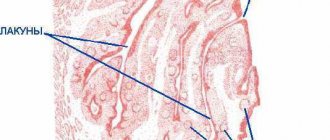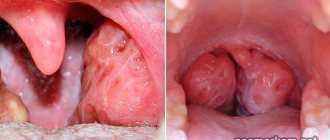Palatine tonsils - a focus of inflammation in chronic tonsillitis
In the upper respiratory tract of a person there are a number of formations representing an accumulation of lymphoid tissue, the so-called lymphoepithelial organs - tonsils. There is a whole lymphopharyngeal ring consisting of 7 tonsils. These are unpaired pharyngeal (adenoids), lingual, laryngeal tonsils, and paired palatine and tubal tonsils. Like any organ in our body, the tonsils can be subject to inflammatory diseases.
Acute inflammation of the tonsils is a sore throat. Chronic tonsillitis refers to a long-term inflammatory process in the palatine tonsils. In most cases, tonsillitis is an exacerbation of chronic tonsillitis. The palatine tonsils (tonsils) are essentially the same mucous membrane only folded into an accordion; they are dotted inside with passages - crypts, which open on the pharyngeal surface of the palatine tonsils with lacunae.
Due to the anatomical features and location of the palatine tonsils, which are located at the crossroads of the digestive and respiratory systems, they are most often, of all other lymphoepithelial formations, susceptible to the inflammatory process, which consists of degenerative processes, as a result of which, in chronic tonsillitis, the palatine tonsils are a constant source of infection and the cause of endointoxication.
Traditional methods of treating purulent plugs
Traditional medicine always acts sparingly, but not as quickly as we would like. The main method here is all kinds of rinsing and restorative drinks.
The variety of rinses is simply beyond description. In addition, if an unpleasant taste appears in your mouth, or saliva becomes viscous (this often happens with chronic tonsillitis), you can immediately help yourself by rinsing your mouth with ordinary boiled water.
During treatment with rinsing, you should always have fresh decoctions and infusions of chamomile, sage, calendula, plantain, oak bark, as well as propolis tincture on hand. The more varied the better.
Rinsing with salt and baking soda also helps a lot. To prepare them, add 1 teaspoon of salt or soda to a glass of boiled water, or both salt and soda at the same time - and the medicine is ready. To enhance the effect, you can add 1-2 drops of iodine to the rinse. But you need to be very careful with iodine, since using it too often will lead to burns, poisoning, or the development of iodism (excess iodine).
With frequent rinsing, the tonsils are freed from the plugs on their own, and recovery occurs.
It is interesting to note that regular and generous gargling will not only keep your throat healthy, but will also help get rid of night snoring. After all, rinsing perfectly trains all the muscles in the oral cavity, and if snoring is not associated with serious heart disease, it will become much less or disappear altogether.
So, dear readers, I hope that you have found useful information in this short article and that your throat will always be in perfect order.
Why do we get chronic tonsillitis?
The main causes of the development of chronic tonsillitis are inflammation of the tonsils and ongoing tonsil reactions, which can be caused by long-term exposure to an infectious factor.
In the photo - lymphopharyngeal ring
During the development of chronic tonsillitis, the overall level of the body’s immunity is of no small importance.
Why do white lumps form on the tonsils?
The tonsils - the palatine tonsils - are very important for human health. They create a barrier to prevent harmful bacteria from entering the body through the blood. These organs of the immune system protect a person from infections, bacteria, viruses that enter by airborne droplets. Sometimes you can find white lumps on the tonsils. They can be soft or have a dense stone-like structure.
White lumps form in the throat in the recesses of the tonsil tissue - lacunae. They can be deep inside without expressing themselves. When they are visible on the surface, this is a clear signal of the development of the inflammatory process. The lumps can be yellowish, grayish or even red. Their systematic appearance indicates chronic tonsillitis. The disease is accompanied by:
- soreness;
- unpleasant odor;
- feeling of a lump in the throat;
- cough;
- pain when swallowing;
- temperature rise.
White lumps in the throat may appear when you sneeze, cough or cough up. Purulent (caseous) plugs reach several centimeters in size. They often have an unpleasant, stinking odor. Its reason is that white growths in the throat are formed when mixing:
- microorganisms;
- waste products of bacteria;
- dead cells;
- leukocytes;
- leftover food.
The exact origin of white lumps in the throat is not known to medicine. There are factors that can trigger their occurrence. It could be:
- drinking cold food and drinks;
- overwork;
- stress;
- bad ecology;
- smoking;
- hazardous production;
- drafts;
- decreased immunity;
- frequent colds;
- streptococcal infection;
- recurring sore throats;
- thrush;
- staphylococcal infection;
- diphtheria.
White spots in a child's throat
Children's bodies are more prone to diseases associated with the mouth and throat. The child may be seriously ill for a long time. He becomes capricious, gets tired quickly, and cries. White lumps appear on the tonsils and the temperature rises. Children are characterized by frequent occurrence of:
- tonsillitis;
- tonsillitis;
- laryngitis;
- pharyngitis.
Child illnesses are difficult trials for parents. If they are associated with throat diseases, you must have an inhalation nebulizer at home. This will help quickly eliminate white lumps and cure a sore throat. To protect your baby from unpleasant diseases, we recommend:
- hardening procedures;
- walks in any weather;
- taking vitamins;
- reduction of loads;
- quality food;
- healthy sleep;
- active physical activity;
- reducing contact with household chemical products.
White spots on the throat of an adult
It's hard to explain, but white lumps are more common in men. They often become signs of chronic tonsillitis. They require regular visits - twice a year - to an ENT doctor. Special rinses help avoid serious complications. The appearance of white growths in the mouth of women during pregnancy is considered dangerous. This can affect the baby’s health and requires immediate attention to specialists.
Types of chronic tonsillitis
There are several classifications of chronic tonsillitis. The issue of classification of chronic tonsillitis is closely related to the clinical manifestations of this disease. The most widely used classification is that there are only two forms: compensated and decompensated.
- The compensated form is characterized by a course without complications, rare sore throats, often the only complaint can be only plugs in the throat, the protective role of the tonsils works by holding back harmful bacteria, and their further penetration, due to this, no special manifestations of the disease are observed.
- Decompensated form This form of chronic tonsillitis is characterized by frequent sore throats at least once a year, the occurrence of local complications, such as peritonsillar abscess, and diseases of other organs and systems of the body, such as glomerulonephritis, rheumatism.
Is white plaque on tonsils dangerous?
Since white plugs in the throat can have different causes, while they themselves are a consequence of pathological processes, it is not entirely correct to talk about their danger.
Rather, the inflammation that caused the formation of plaque is dangerous. To avoid serious complications, you need to understand what led to the formation of traffic jams. The most severe consequences include peritonsillar abscess. It often leads to the formation of phlegmon, and in some patients it leads to the development of sepsis, a life-threatening infection. You don't need to worry about cheesy plugs in all cases. So, if the general condition is good, and it is revealed that the plaque appeared as a result of tonsillitis, you don’t have to worry, but simply treat the purulent plugs in the throat in accordance with the instructions of the attending physician. But if plaque forms several times during the year, and the patient’s condition is characterized by headaches, joint, muscle pain and a general deterioration in health, it is necessary to consult an otolaryngologist. Most likely, he will prescribe lavage of the nasopharynx.
A situation where traffic jams are almost always present should be a serious cause for concern. This suggests that the tonsils are not coping with their functions. On the contrary, they pose a threat to the body as a source of infection, and in this case it is advisable to remove them.
Symptoms of chronic tonsillitis
The main manifestation of chronic tonsillitis is tonsillitis; as a rule, all patients suffering from this disease at least once have had tonsillitis. Sore throat is a fairly serious disease that affects all systems of the body and carries the risk of a number of serious complications, so the choice of treatment tactics for chronic tonsillitis should be related to the frequency of tonsillitis. The main symptoms of the disease can be identified:
| Smell from the mouth | One of the most common symptoms disturbing the patient is bad breath. This symptom is due to the fact that the area of the epithelium of the palatine tonsil is quite large; during inflammation, pathological secretions accumulate in the crypts of the tonsils in the form of caseous (curdled) masses. Caseous masses are evacuated through the lacunae into the pharyngeal cavity, causing bad breath. |
| Sore throat, ear | One of the main symptoms of chronic tonsillitis is pain in the throat, often a feeling of a lump in the throat. Also, the symptoms of chronic tonsillitis can be expressed by headache, unpleasant sensations in the ear, mild pain in it, which is caused by irritation of the nerve endings in the parenchyma of the palatine tonsil and irradiation of pain along the nerve fiber to the ear. |
| Enlarged lymph nodes | You can often observe an enlargement of the lymph nodes located under the jaw, and the cervical lymph nodes also enlarge. When palpating the lymph nodes, mild pain occurs. |
Quite a large number of patients do not immediately detect the symptoms of chronic tonsillitis and delay contacting an ENT doctor, which often leads to decompensation of the disease and longer treatment in the future.
Pus in the throat: symptoms, causes, photos - what to do and how to treat?
Pus in the throat photo
Traffic jams are a factor by which chronic tonsillitis can be recognized. Therefore, when traffic jams appear, all the signs of this chronic disease are present. The following symptoms can be identified during an exacerbation of tonsillitis.
Constantly recurring sore throats - if there is inflammation in the tonsils, then this is not an indicator of chronic tonsillitis. But if a person is susceptible to the disease more than two or three times a year, then we can confidently say that we are dealing with a chronic form of the disease.
The next symptom is redness and swelling of the palatine arches, to which inflammation from the tonsils can spread. Adhesions can form between the palatine arches and the tonsils - they seem to stick together with each other.
Enlarged lymph nodes are another sign of the disease. The manifestation of tonsillitis is accompanied by elevated body temperature. In the chronic form, a temperature of 37°C can last from several days to several weeks. The patient feels constant fatigue, lethargy, and performance decreases. All these are signals of adverse changes occurring in the body.
The first sign is a feeling that there is something in the throat: like a lump; A dry cough may accompany these unpleasant sensations. The patient has difficulty swallowing and has a sore throat.
Severe pain in the throat is accompanied by a putrid odor from the mouth, which cannot be muffled even with the help of toothpastes. This smell is the result of the activity of bacteria accumulated in traffic jams. Caseous formations are also visible upon visual inspection - curdled tubercles of a white-yellow hue are immediately noticeable on the tonsils.
Blockages in the tonsils can bring a lot of unpleasant and even dangerous consequences to the patient: if the infection travels with the blood or lymph flow further through the body, it can cause problems with the heart, kidneys and joints. In order not to have to treat complications from tonsillitis, it is necessary to get an appointment with an otolaryngologist in a timely manner and begin treatment for tonsillitis with purulent plugs.
It all starts with a sore throat, which is characterized by symptoms:
- sore throat (constant or intermittent);
- cough (with coughing up pus);
- redness in the throat;
- swelling.
First of all, it is necessary to prevent the development of fibrous tonsillitis and its consequences. And for this you need to maintain oral hygiene, gargle, but the doctor always sets the tone, it is an experienced ENT doctor who prescribes the treatment regimen.
If there are already such plugs on the tonsils, then the basis of treatment will be antibacterial therapy. Streptococcus, the microbe that causes sore throats, is very similar to proteins in the heart valve and joints. And here a paradox arises - the body tries to kill the unwanted guest, but at the same time begins to have a detrimental effect on the heart and joints.
The antibiotic helps to direct all forces towards the destruction of streptococcus. If you do not treat a sore throat with antibiotics, you risk getting a source of chronic inflammation in the throat, which will then cause all the side effects.
How to identify chronic tonsillitis
Diagnosis of chronic tonsillitis does not present any particular difficulties for an experienced otolaryngologist. The patient's medical history and complaints are of utmost importance in diagnosis; as a rule, the history includes previous sore throats and complaints of frequent pain and discomfort in the throat.
Examination of the throat for chronic tonsillitis
During mesopharyngoscopy (examination of the pharynx) for chronic tonsillitis, the following signs are present: hyperemia and roller-like thickening of the edges of the palatine arches; cicatricial adhesions between the tonsils and palatine arches; loosened or scarred and hardened tonsils; caseous-purulent plugs or liquid pus in the lacunae of the tonsils.
Prevention
To avoid the appearance of tonsillitis plugs, you need to follow simple preventive rules:
- Treat inflammatory diseases in a timely manner, avoiding exacerbations (tonsillitis, sore throat, caries, etc.).
- Maintain oral hygiene (timely brushing, removing food debris).
- Avoid hypothermia and dress appropriately for the weather.
- Do not use other people's personal hygiene items (toothbrush, toothpaste, etc.).
- Strengthen the immune system (through proper nutrition, hardening the body, taking vitamins, etc.).
Tonsillitis plugs are a severe inflammatory disease that causes pain and discomfort to a person. Therefore, at the first symptoms of inflammation (sore throat, sensation of a foreign object in the mouth, etc.), you should consult a doctor. Removing plugs on your own and taking medications uncontrolled can only cause harm. To speed up the healing process, both medications and folk remedies can be used as therapy. But it’s even better to prevent the appearance of purulent plugs and treat existing pathologies in a timely manner.
- Atlas of Oral Diseases / Robert P. Langlais, Craig S. Miller. — M.: GEOTAR-Media
- Polunina T.A.
Tonsillectomy in children // Issues of modern pediatrics. — 2012 - Galina Kolosenko.
.
Health
. Arguments and Facts
Complications of chronic tonsillitis
Chronic tonsillitis has serious complications; they are divided into two groups: local and general. All complications, as a rule, occur during an exacerbation of the process occurring in the form of a sore throat and represent the consequences of untimely treatment of chronic tonsillitis.
With chronic tonsillitis, in the upper respiratory tract of a person, more precisely in the palatine tonsils, there is a focus of chronic inflammation; the problem of focal infection is very acute in modern medicine. Currently, there are about fifty different metatonsillar diseases, which are the result of chronic inflammation in the palatine tonsils. Let's take a closer look at what this can most often threaten.
Peritonsillar abscess
This is the most common local complication. The fact is that between the palatine tonsil and the muscles of the pharynx to which it is attached there is fiber, the so-called paratonsillar fiber. With severe inflammation, the infection can enter this tissue through the hematogenous route, causing its infiltration and purulent melting, and an abscess is formed. Peritonsillar abscess is a very serious disease that requires immediate surgical treatment, usually in a hospital setting, since there is a threat of the purulent process spreading through the cellular spaces of the neck into the mediastinum, which can be fatal.
Diseases of the heart, joints and kidneys
An important role in the inflammatory process in chronic tonsillitis is played by group A beta-hemolytic streptococcus, which often parasitizes the palatine tonsils. The fact is that immune complexes that form in the body as a response to the aggression of this antigen can also attack healthy tissue in the joints, heart and kidneys, which, if not treated in a timely manner, can even lead to disability.
Weakness and decreased ability to work
The parenchyma of the palatine tonsils is densely penetrated by blood and lymphatic vessels, and in the thickness of the organ there are many nerve endings that connect to important autonomic centers. In chronic tonsillitis, inflammatory products enter the circulatory and lymphatic systems, and constant endotoxification occurs. All these factors plus pathological impulses from irritated nerve endings lead to decreased tone, bad mood, and apathy.
Regular colds
With chronic tonsillitis, the body spends a lot of effort to contain inflammation in the tonsils, the immune system is under constant stress, which leads to its significant weakening. Added to this is the not always correct work-rest regime, nutrition, and environmental conditions, as a result of which a person with chronic tonsillitis may literally not “get out” of a cold.
Inflammatory diseases of the respiratory system
The palatine tonsils are anatomically located in the pharynx, close to such organs as the trachea, larynx, and paranasal sinuses. With chronic tonsillitis, microbial contamination of the entire area of the respiratory mucosa occurs, which contributes to the development of diseases such as sinusitis, bronchitis, and laryngitis.
Stomach and intestinal problems
The palatine tonsils are located at the crossroads of the digestive and respiratory systems. Due to certain anatomical features, they represent a rather large conglomerate of the mucous membrane. In chronic tonsillitis, this entire area of the mucosa is involved in the inflammatory process and secretes a pathological secretion in the form of a liquid fraction and caseous masses. This pathological content is evacuated into the pharynx through lacunae and then swallowed with saliva, which often causes disturbances in the functioning of the gastrointestinal tract.
Why are purulent plugs in the throat dangerous?
If traffic jams and inflammation are not eliminated, the disease can affect the heart and kidneys. Inflammation can affect joints and skin. When pyogenic bacteria penetrate from the throat into the blood, it can become infected and spread the infection to other tissues and organs. There are also known cases of replacement of lymphatic tissues in the palatine tonsils with scar tissue.
Common complications are neck cellulitis and peritonsillar abscess. In the first case, infectious inflammation of the subcutaneous tissue of the neck occurs and, in the absence of surgical treatment, there is a high probability of death. In the second case, the inflammation spreads to the fiber surrounding the tonsils and causes an acute inflammatory process.
Surgical treatment of chronic tonsillitis
The whole variety of methods for treating chronic tonsillitis is divided into two large groups: surgical methods and conservative ones. Let us dwell in detail on surgical treatment. A radical surgical method is tonsillectomy - removal of the organ along with the capsule should not be confused with tonsillotomy, which is often done in childhood.
Video: tonsillectomy - removal of tonsils
With tonsillotomy, unlike tonsillectomy, not the entire organ is removed, but only a fragment of the hypertrophied parenchyma of the pharyngeal surface of the tonsil. It is necessary to resort to tonsillectomy in extreme cases; for this there must be compelling indications, such as a complicated advanced form of the disease, despite the fact that all possible methods of conservative treatment have been exhausted. Despite these “canons” that have been established for many years, removal of tonsils is often resorted to due to the lack of availability of conservative treatment, and sometimes due to the banal lack of a competent specialist dealing with this issue.
The function of the palatine tonsils is extremely important - it is an element of the pharynx, after the removal of these organs, areas of the pharynx that were covered by these formations begin to be subject to irritation by air and food masses, is this good or bad? Apparently this is bad, since nature, as a result of a long process of evolution, did not give us a single extra organ.
Preparation of an ozonized solution for a session of deep vacuum ultrasonic sanitation of the palatine tonsils
Often, tonsils are removed from patients who have not even had a history of sore throat, and whose only complaint was caseous plugs in the throat and bad breath. The long-term result of operations to remove palatine tonsils is often severe sore throat and the development of atrophic pharyngitis, which is difficult to treat.
Conservative methods of treating chronic tonsillitis include various methods of washing the tonsils. Comprehensive information about this manipulation is presented in the article washing the tonsils.
Other treatment methods for frequent relapses of the disease
When consulting about throat congestion, a doctor may suggest a rinsing procedure. If tonsillitis occurs frequently or chronic tonsillitis is observed with the constant formation of plugs, then most likely you cannot do without it. Washing is carried out on an outpatient basis with special solutions. The procedure is not very pleasant, but very effective. As a result, pus is washed out even from the deepest and most distant lacunae. It needs to be done regularly, approximately once every six months. In advanced and severe conditions, hardware methods are recommended. These can be ultrasonic waves on the tonsil area, microcurrents, phonophoresis. In extreme cases, surgical intervention is indicated. But you shouldn’t let your throat get to this point. The main thing is to consult a doctor and choose the optimal treatment method.
During pregnancy and lactation, treatment of sore throat and purulent plugs is carried out under the supervision of a doctor. All drugs, and especially herbs and homeopathy, are agreed upon regarding their benefits to the woman and harm to the child.
Treatment of chronic tonsillitis without surgery
Despite the wide market of medical services, there are not so many effective conservative methods of treating chronic tonsillitis. The fact is that in modern otorhinolaryngology it is customary to divide the mucous membrane into fragments, there are doctors who deal only with diseases of the nose - rhinologists, there are specialists who deal only with the treatment of the throat. In fact, the entire area of the mucous membrane lining the upper respiratory tract is one organ.
Session of deep vacuum ultrasonic sanitation of palatine tonsils with ozonated solution
We are forced to obtain oxygen from the air, and the air is not sterile; the respiratory organs, like no other system of our body, experience a colossal biological load and are constantly in contact with microbes. The anatomical structure of the upper respiratory tract is the product of a long period of evolution. The upper respiratory tract is a complex mechanism created by nature with one purpose: to be a protective barrier. Moreover, many ENT diseases (adenoids, vasomotor rhinitis, sinusitis, chronic pharyngitis), which are classified as different and treated in different ways, are essentially one disease in different stages of development, so to speak, a “machine” in different stages of breakdown.
Video: treatment of chronic tonsillitis
So, the essence of many inflammatory ENT diseases, including chronic tonsillitis, is a degenerative process in the mucous membrane, caused by the microbes that we breathe, as a result of the weakening of the protective properties of the mucous membrane. It follows from this that when doing treatment you need to influence the entire area of the mucous membrane of the upper respiratory tract, you just need to take into account some anatomical features - such as the structure of the palatine tonsils, and taking these features into account, locally enhance the therapeutic effect. Since the palatine tonsils are essentially the same mucous membrane only folded into an accordion, washing the tonsils should be an integral part of the treatment process.
Conducting a photodynamic therapy session on the pharynx area for chronic tonsillitis
The lack of effective methods for treating chronic tonsillitis is also due to the fact that there are a number of dogmas in modern medicine. One of them is that the most common way to fight germs today is with antibiotics. Antibiotics, unfortunately, do not penetrate well into the upper layers of the degenerative mucous membrane; moreover, they do not restore it. With chronic inflammation, the regeneration of the mucous membrane is disrupted and microerosions form on it. Figuratively speaking, the mucous membrane becomes like a “sieve,” which is the most important basis for the inflammatory process.
Stimulation of reflexogenic zones in chronic tonsillitis
Taking into account the above, the main task of treating chronic tonsillitis is to influence all parts of the pathogenesis of the disease, therefore the following methods are used in our clinic:
| Cleansing tonsils with ozonized solution | In our clinic, we wash the palatine tonsils using the tonsillor apparatus with an ozonated solution, which is by far the most effective way to cleanse the entire thickness of the tonsils from pathological contents. |
| Sanitation of mucous membranes with mineral salts | In our clinic, we irrigate the entire mucous membrane with a solution of individually selected mineral salts, which sanitize the mucous membrane and restore it, which cannot be achieved with modern antibiotics. We also activate mucosal regeneration using photodynamic therapy. Lymph stasis plays an important role in the pathogenesis of inflammation, including chronic tonsillitis. Activation of lymph flow in the area of inflammation plays an important role: this is how the “soldiers” of our immunity - lymphocytes - move along with lymph. |
| Stimulation of reflexogenic zones | With the help of injections into the reflexogenic zone of the neck, ozone causes a spasm of the subcutaneous lymphatic vessels, which activates the lymph flow in the pharynx, leading to rapid stabilization of the immune system. The integrated approach we use affects all parts of the pathogenesis of chronic tonsillitis, which allows it to be treated conservatively, avoiding surgical treatment. |
How to rinse tonsils at home?
There are several ways to cleanse the recesses in the tonsils on your own. These include:
- rinsing;
- eliminating purulent plugs using cotton swabs and disks;
- treatment with a syringe (without a needle);
- use of an irrigator.
The main requirement before using the above procedures is to visit an ENT doctor who will instruct the patient on the nuances of treatment. Incorrect therapy at home will lead to deterioration of health, injury to soft tissues, and accelerated spread of pathogens.
When planning to carry out any therapeutic manipulations, wash your hands thoroughly with soap!
Before treatment, it is recommended to watch a video about washing the tonsils:
Rinse
This type of cleaning is suitable for removing plaque formed in the initial stage of the disease. His technique is simple: just take the medicinal solution into your mouth, and, throwing your head back, rinse the mucous membranes.
Herbal mixtures used for treatment should be warm; antiseptics - at room temperature.
Rinsing duration is at least 3 minutes. Frequency - at least 8 times a day.
Trying to wash the lacunae of the tonsils at home by rinsing is not advisable: medicinal solutions only affect the outer part of the tonsils, while the plugs are located deep in the lymphoid tissue.
Washing tonsils at home using cotton pads and swabs
These washing methods consist of two stages:
- cotton pads/sticks are moistened with a disinfectant solution;
- problem areas are wiped with gentle movements.
A cotton swab is quite convenient for removing loose deposits at home.
: to remove the plugs from the recesses of the tonsils, you need to lightly press on the tonsils below the location of the purulent formation.
Using a syringe
Before you rinse your tonsils at home using a syringe, you need to prepare a solution of furatsilin (the principle of preparing a disinfectant liquid is discussed below). The throat is gently irrigated from a medical instrument.
You should rinse the lacunae with a syringe in front of a mirror.
It is forbidden to swallow the liquid after completion of therapy - it contains pathogens washed off from the surface of the tonsils.
It is recommended to wash the tonsils in this way at least 5 times a day.
Using the irrigator
The device used for treatment is called a “laryngeal” syringe. Its main difference from a conventional medical instrument is its elongated curved tip. Only a doctor will give a detailed answer to the question of how to wash your tonsils at home using an irrigator. The treatment process can be briefly described as follows:
- The syringe is filled with a medicinal substance.
- The nozzle is carefully inserted into the tonsil lacuna.
- The recesses are washed by pressing the piston of the device.
Cleaning is carried out from 1 time per day.
The disadvantages of using an irrigator include the risk of injury to the lacuna and the possible pushing of plugs deeper into its tissue.
Prevention of relapse
Preventing the recurrence of traffic jams is a set of measures. The patient must be under dispensary observation, that is, the patient must be periodically examined by an otolaryngologist in medical institutions for a certain time.
The patient must undergo courses of anti-relapse therapy. Together with the doctor, it is necessary to ensure that the patient does not have a sore throat. This is a very large amount of work, and it is performed by an otolaryngologist.
These include: local lavage of the tonsil outlets, various local anti-inflammatory drugs, physical therapy. All complex treatment is aimed at stopping relapses of the disease.
A patient may suffer for years from the appearance of plugs in the throat, but here you need to understand that they will continue to appear until the person takes treatment and undergoes the whole range of procedures. After which it will be necessary to constantly prevent the occurrence of inflammation in the tonsils in order to forget about this disease forever.
//www.youtube.com/watch?v=cxKte7uuRkw








